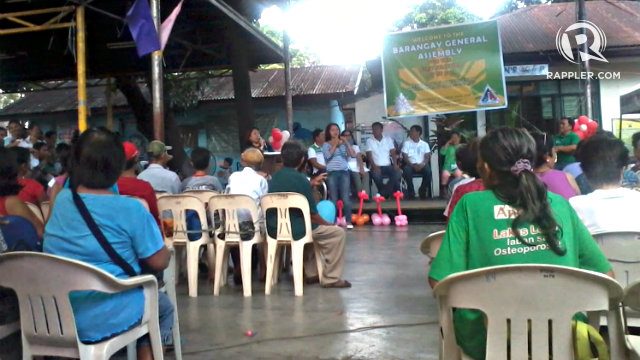SUMMARY
This is AI generated summarization, which may have errors. For context, always refer to the full article.
 Who are the barangay officials in your neighborhood?
Who are the barangay officials in your neighborhood?
That’s one important reason why you should go to your barangay hall this Saturday, March 25, 2017; but in addition to that, I’ll add 96,081,721,176 more.
That’s right. That’s a little more than P96 billion, the total amount allocated by the National Government as the Internal Revenue Allotment (IRA) share of 41,889 barangays, as declared by DBM Local Budget Memorandum No. 68, dated June 15, 2016.
To help put these numbers in perspective, that’s nearly 170 times the transfer cost to get the BRP Gregorio del Pilar, our current flagship, and please note that this alloted amount is only for fiscal year 2015. All barangays nationwide will always receive their share of the IRA (as they have been doing so, since 1992), which makes them a special class of corporate body, one that will never go bankrupt.
Barangays do not live on IRA alone. They also receive grants, subsidies, contributions, and resource support from their parent cities and municipalities, from their local Congressperson, and even from friendly senators. Barangays also have the power, through an ordinance, to impose taxes and fees within their jurisdiction, in addition to receiving a percentage of the collections from the ubiquitous cedula (community tax certificate) and, more significantly, the real property tax.
To say that a barangay has “no budget” is a misleading statement, as barangays have a multitude of revenue sources, as well as a plethora of fund-raising options granted to them by the Local Government Code.
The burning question, no doubt, in every long-suffering taxpayer’s mind, is: Where does all this money go?
Your barangay treasurer knows, but you should, too
DILG Memorandum Circular 2014-81, dated July 15, 2014, mandated the creation of viewable Barangay Full Disclosure Boards in all barangays nationwide, requiring all punong barangays to ensure public access to the details of the:
- Barangay Budget (also known as the Barangay Appropriations Ordinance)
- Summary of Income and Expenditures for the previous year
- Annual Procurement Plan
- Notices of Awards of barangay bidding projects
- monthly list of itemized collections and disbursements
- and how the Barangay Development Fund (constituting 20% of the IRA) was spent
Section 513 of the Local Government Code is also fairly explicit:
“Failure by the local treasurer or the local chief accountant to post the itemized monthly collections and disbursements of the local government unit concerned within ten (10) days following the end of every month and for at least two (2) consecutive weeks at prominent places in the main office building of the local government unit concerned, its plaza and main street, and to publish said itemization in a newspaper of general circulation, where available, in the territorial jurisdiction of such unit, shall be punished by a fine not exceeding Five hundred pesos (P500.00) or by imprisonment not exceeding one (1) month, or both such fine and imprisonment, at the discretion of the court.” (emphasis mine)
Please note that this penalty is for each instance the local treasurer fails to post this financial statement at the end of every month.
Mandatory slices of the barangay budget pie
Section 329 of the Local Government Code specifies that 10% of the barangay general fund is allocated for the Sangguniang Kabataan (currently the Task Force on Youth Development).
Not less than 5% of estimated revenues from regular sources is allocated for the Local Disaster Risk Reduction and Management Fund.
Section 36 of The Magna Carta of Women (Republic Act 9710) mandates that 5% of the total budget appropriations of the barangay be used for programs addressing gender and development issues and concerns.
Section 15 of the Juvenile Justice and Welfare Act of 2006 (Republic Act 9344) established a Local Council for the Protection of Children in all levels of local government, including the barangay, and allocates 1% of the IRA of each LGU for the strengthening and implementation of the LCPC.
In addition to these, Section 331 (b) of the Local Government Code limits barangay spending for personal services (salaries and similar items) to 55% of the annual income realized from local sources for the preceding year.
How the budget is appropriated in your barangay reveals the priorities of your barangay government.
Section 395 (e) 5 of the Local Government Code provides that the barangay treasurer shall render a written accounting report of all barangay funds and property under his custody at the end of each calendar year, and ensure that such report shall be made available to the members of the barangay assembly and other government agencies concerned. (emphasis mine)
This means that you have the right to know how all barangay funds were spent last 2014, as well as what property the barangay currently possesses. Under the Anti Red-Tape Act of 2007, failure of the punong barangay to ensure submission of this report by the barangay treasurer will merit administrative sanctions.

Barangay assemblies
Punong barangays are directed to convene their respective Barangay Assemblies on Saturday, March 28, 2015. The Barangay Assembly is required to meet twice a year, but it can (and should!) also meet anytime its members want it to, to discuss matters concerning the barangay. As the people’s assembly, it does not require the presence of barangay officials to begin proceedings.
Originally instituted in 1960, and existing in its present form since 1991, by virtue of Sections 397 and 398 of the Local Government Code, the Barangay Assembly in every barangay is composed of all Filipino citizens 15 years old and above, who have been residing in the barangay for at least 6 months. You do not have to be a registered voter to attend and participate. It is, in effect, a neighborhood congress, more powerful than any homeowners’ association. If the barangay were a corporation, the Barangay Assembly would be the duly-convened stockholders’ meeting.
Not many Filipinos realize that the Barangay Assembly is a potentially game-changing institution in itself.
As a member of the Barangay Assembly, you have the powers to:
- Pass resolutions requiring barangay government action on any matter involving the welfare of the barangay
- Directly initiate legislation through local initiative – where the registered voters directly enact barangay ordinances
- Hear and pass upon (or even reject!) the semestral report of the Sangguniang Barangay concerning its activities and finances
Leadership is a choice
To paraphrase Sir Richard Branson, serial entrepreneur: The one person who can make your community succeed is not your Mayor, nor your Governor, nor your Punong Barangay. It is you.
Be an active member of your #BrgyAssembly! – Rappler.com
Lou Gepuela is a Filipino citizen who believes that sustained public engagement with government and continued community empowerment is the missing link in fixing a significant portion of society’s ills. He spent 5 years learning and applying process improvement, people management, and customer care skills in the local BPO industry.
iSpeak is a parking space for ideas and opinions worth sharing. Send your article contributions to move.ph@rappler.com
Add a comment
How does this make you feel?
There are no comments yet. Add your comment to start the conversation.